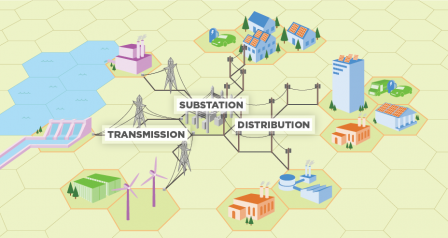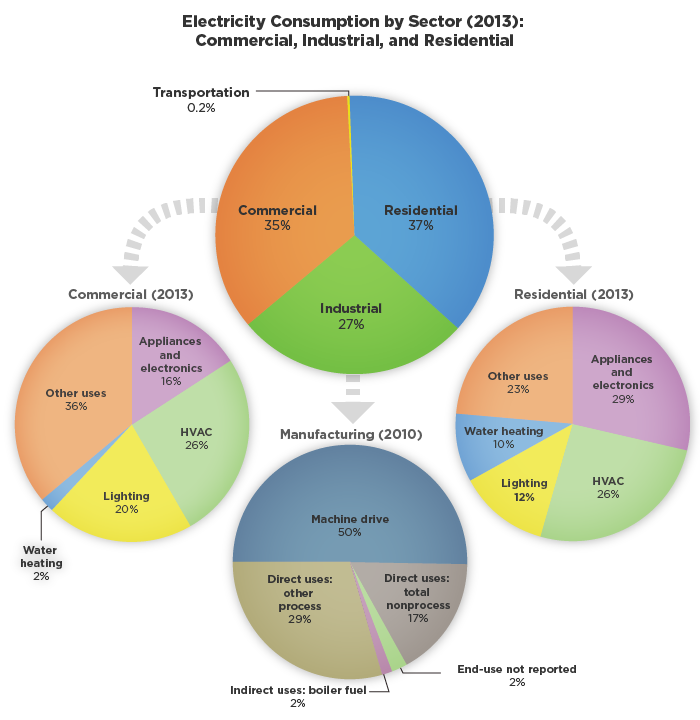Electricity Customers
 View an interactive version of this diagram >>
View an interactive version of this diagram >>
Overview
Residential, commercial, and industrial customers each account for roughly one-third of the nation’s electricity use. The transportation sector accounts for a small fraction of electricity use, though this fraction could increase as electric vehicles become more widespread. All types of end-users can reduce electricity use through energy efficiency.
 Sources: The high-level sector breakdown and detailed commercial and residential breakdowns come from the U.S. Energy Information Administration’s Annual Energy Outlook 2014. These data reflect projections for 2013. Energy uses within the industrial sector are not available with the same breadth, precision, or timeliness, so the best available source was the U.S. Energy Information Administration’s Manufacturing Energy Consumption Survey, which was last conducted in 2010.
Sources: The high-level sector breakdown and detailed commercial and residential breakdowns come from the U.S. Energy Information Administration’s Annual Energy Outlook 2014. These data reflect projections for 2013. Energy uses within the industrial sector are not available with the same breadth, precision, or timeliness, so the best available source was the U.S. Energy Information Administration’s Manufacturing Energy Consumption Survey, which was last conducted in 2010.
Residential Customers
The residential sector includes single-family homes and multi-family housing, and it accounts for more than a third of the electricity used nationwide. As the graph shows, on average, the biggest single uses of electricity in the residential sector are space heating and cooling (air conditioning), lighting, water heating, space heating, and appliances and electronics. Electricity demand in the residential sector tends to be highest on hot summer afternoons due to increased air conditioning use, followed by evenings, when lights are turned on.
Commercial Customers
The commercial sector includes government facilities, service-providing facilities and equipment, and other public and private organizations. This sector accounts for more than a third of U.S. electricity consumption. As the graph shows, on average, the biggest single uses of electricity in the commercial sector are lighting and heating, ventilation, and air conditioning. Electricity demand in the commercial sector tends to be highest during operating business hours; it decreases substantially on nights and weekends.
Industrial Customers
Industrial customers’ facilities and equipment use electricity for processing, producing, or assembling goods, including such diverse industries as manufacturing, mining, agriculture, and construction. Overall, this sector uses less than a third of the nation’s electricity. Data on specific end-uses are available from a broad nationwide survey of manufacturing facilities, which found that more than half of the electricity used in manufacturing goes to powering various motors (machine drive). Other sizable uses include heating, cooling, and electro-chemical processes in which electricity is used to cause a chemical transformation (for example, the processes that produce aluminum metal and chlorine). Electricity use in the industrial sector tends not to fluctuate through the day or year as in the residential and commercial sectors, particularly at manufacturing facilities that operate around-the-clock.
Transportation
The transportation sector consumes most of its energy by directly burning fossil fuels such as gasoline, diesel, and jet fuel. However, some vehicles use electricity from the electric power grid instead. These vehicles include battery-powered electric cars and plug-in hybrid electric cars that store power from the grid when they charge their batteries; various types of electric vans, trucks, and buses that do the same; and subway, electric rail, and trolley systems that are continuously connected to the electric power grid. Transportation activities account for less than 1 percent of total U.S. electricity use, but this percentage could grow as electric vehicles become more common. These vehicles can potentially even feed power back into the grid when demand from other sectors is high, which means the vehicles’ batteries are providing storage capacity for the grid.
